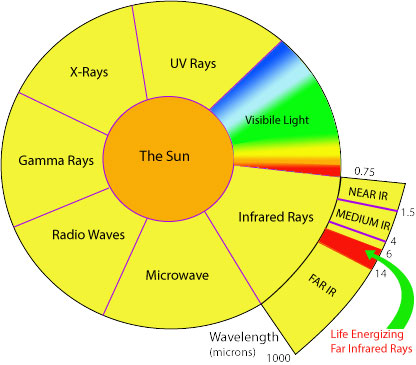Posted by BiomatStores.com on 8th Jan 2024
Near Infrared vs Far Infrared Therapy: Which One is Right for You?
Near and Far Infrared Therapies: Definitions, Applications, Similarities, and Differences
How Infrared Therapy Works
Visible light is a very small piece of the electromagnetic spectrum. Infrared light is part of the light spectrum that cannot be seen by the human eye. Infrared therapy works by utilizing infrared light waves to penetrate the body's tissues and generate heat. This heat creates health benefits that depend on which type of infrared therapy experienced.
Understanding Far Infrared Therapy

What is Far Infrared Light?
Far infrared light refers to electromagnetic radiation with longer wavelengths than those of visible light. It falls into the infrared region of the electromagnetic spectrum and is typically defined as radiation with wavelengths ranging from 15 to 1000 micrometers. It is located farthest from visible light within the infrared part of the light spectrum and has the longest wavelength within that spectrum. Far infrared light is also known as thermal or long-wave infrared light. It is invisible to the human eye but can be felt as heat.
How Does the Body Absorb Far Infrared Light?
Far infrared light is absorbed by the body through a process known as resonant absorption. When far infrared light penetrates the skin, it interacts with water molecules in the body's tissues. These water molecules vibrate in resonance with the frequency of the infrared light, causing them to release energy and generate heat. This heat then spreads throughout the body, increasing blood flow and promoting various physiological responses.
What are the Health Benefits of Far Infrared Therapy?
1. Pain relief: Far infrared therapy has been shown to be effective in reducing pain, particularly in conditions such as arthritis, muscle soreness, and joint inflammation.
2. Improved circulation: The heat from far infrared therapy helps to dilate blood vessels and increase blood flow, promoting better circulation throughout the body. This can help to deliver more oxygen and nutrients to tissues and organs.
3. Detoxification: Far infrared therapy can induce sweating, which is one of the body's natural ways of eliminating toxins. Sweating through far infrared therapy has been found to release heavy metals, chemicals, and other toxins from the body.
4. Relaxation and stress relief: The deep penetrating heat of far infrared therapy can promote relaxation and stress reduction by soothing tense muscles, relieving anxiety, and promoting a sense of overall well-being.
5. Boosted immune system: Regular use of far infrared therapy has been associated with an improved immune response, helping to strengthen the body's natural defense mechanisms and protect against illness and infection.
6. Enhanced metabolism: Far infrared therapy can stimulate the metabolic rate, increasing calorie burning and promoting weight loss. It may also help to regulate hormones and improve digestion.
7. Improved sleep: The relaxation and stress reduction benefits of far infrared therapy can contribute to better sleep quality, aiding those who struggle with insomnia or disturbed sleep patterns.
8. Accelerated wound healing: The increased circulation and oxygenation provided by far infrared therapy can help to speed up the healing process of wounds, injuries, and surgical incisions.
9. Reduced inflammation: Far infrared therapy has been found to have anti-inflammatory effects, helping to reduce swelling, pain, and stiffness in muscles, joints, and tissues.
10. Better sleep: Far infrared therapy has been found to alleviate occasional sleeplessness.
11. Raise core body temperature: The deep heat can raise the temperature of the body. For every degree the body temperature is raised, the immune system is exponentially improved.
What are the Applications of Far Infrared Therapy?
Far infrared light is commonly used in various medical and wellness applications, including saunas, heating pads, and therapeutic devices, due to its ability to provide therapeutic effects at a cellular level.
In the field of pain management, far infrared therapy has shown promising results. It is commonly used to alleviate symptoms associated with conditions such as arthritis, fibromyalgia, and musculoskeletal injuries. The heat generated by far infrared therapy helps to increase circulation, reduce inflammation, and relax muscles, providing relief from pain and stiffness.
In addition to pain management, far infrared therapy is also utilized in wound healing. The deep penetration of far infrared radiation stimulates blood flow and aids in the delivery of vital nutrients to the injured area, accelerating the healing process. It has been found effective in treating muscle and joint injuries and post-surgical wounds.
Furthermore, far infrared therapy has been found to have a positive impact on cardiovascular health. It is believed to improve blood circulation, regulate blood pressure, and boost endothelial function. Studies have also shown its potential in reducing oxidative stress, which is associated with various cardiovascular diseases.
Additionally, far infrared therapy has shown promise in promoting relaxation and reducing stress. It is often used in stress management programs, as the gentle heat induces a sense of calm and relaxation, leading to improved sleep quality and overall mental well-being.
Far infrared therapy has demonstrated its potential in various areas of healthcare, providing non-invasive and natural solutions for pain management, wound healing, cardiovascular health, and relaxation. Further research and advancements in technology are expected to broaden its applications and enhance its efficacy in the field of healthcare.
Understanding Near Infrared Therapy
What is Near Infrared Light?
Near-infrared light refers to the electromagnetic radiation with wavelengths ranging from 700 to 2500 nanometers, which is just beyond the visible light spectrum. It is characterized by its ability to penetrate through biological tissues and materials to a certain depth. Near infrared light is invisible to the human eye but is located closest to the visible part of the light spectrum amongst infrared light. It is right next to red visible light which is why it is often paired with "red light therapy". It has the shortest wavelength of all infrared light.
How Does the Human Body Absorb Near Infrared Light?
Near infrared light is absorbed by the body through a process called photobiomodulation. When near infrared light is applied to the skin, it penetrates the tissues and is absorbed by the mitochondria, which are the powerhouses of the cells. The mitochondria then convert the energy from the light into a form that the cells can use, known as ATP.
What are the Health Benefits of Near Infrared Light Therapy?
1. Near infrared light therapy has been shown to improve circulation and increase blood flow near the surface of the body.
2. It has been found to stimulate the production of collagen, a protein that is essential for maintaining healthy skin and preventing the signs of aging.
3. It can aid in the healing process of wounds and injuries, as it promotes the formation of new tissue and accelerates the repair of damaged cells near the surface of the body.
4. It can enhance the production of ATP (adenosine triphosphate), which is the energy currency of the cells, leading to increased energy levels and improved overall vitality.
7. Near infrared light therapy has been found to stimulate the production of endorphins, which are natural painkillers and mood boosters, providing relief from pain and promoting feelings of well-being.
8. It can help regulate sleep patterns and improve the quality of sleep, leading to better overall rest and recovery for the body.
9. It can provide pain relief from issues near the surface of the body.
10. It can raise core body temperature.

What are the Applications of Near Infrared Light Therapy?
Near infrared light therapy, also known as low-level light therapy or photobiomodulation, is a non-invasive, drug-free treatment method that uses near-infrared light to promote healing and improve various health conditions. This therapy has gained popularity in recent years due to its wide range of applications and potential benefits.
One of the primary applications of near infrared light therapy is in pain management. It has been shown to effectively reduce pain and inflammation by increasing blood flow and promoting the release of endorphins. It can be used to alleviate acute and chronic pain, including musculoskeletal pain, joint pain, and neuropathic pain.
Another important application is wound healing. Near infrared light therapy has been found to stimulate the production of collagen and enhance tissue repair, making it beneficial for wound healing, including diabetic ulcers, burns, and surgical wounds. It can also help reduce scars and improve overall skin health.
In addition, near infrared light therapy has shown promise in treating neurological conditions such as traumatic brain injuries, stroke, and neurodegenerative disorders. It has been found to stimulate the production of ATP, a source of cellular energy, and improve mitochondrial function, which is crucial for optimal brain health.
Furthermore, near infrared light therapy has applications in dermatology, promoting skin rejuvenation, reducing acne, improving skin tone, and treating conditions such as rosacea and psoriasis. It also has potential benefits in improving athletic performance, enhancing muscle recovery, and reducing fatigue.
Overall, near infrared light therapy holds immense potential in various fields and can be a valuable adjunctive treatment method for a wide range of health conditions. As research continues to uncover more applications and benefits, its use is likely to expand further in the future.
Comparing Far and Near Infrared Therapies
Similarities Between Near and Far Infrared Therapies
Near and far infrared therapies are both forms of heat therapy that utilize infrared radiation to provide healing and therapeutic effects to the body. Despite their differences in wavelength and penetration, they share some key similarities.
Firstly, both near and far infrared therapies work by generating heat in the body. This heat promotes vasodilation, improving blood circulation and oxygenation of tissues, which can aid in relieving pain and inflammation. The increased blood flow also helps to flush out toxins and metabolic waste products from the tissues, promoting overall healing and recovery.
Secondly, both therapies have been found effective in promoting relaxation and reducing stress. The heat generated by both near and far infrared therapy can penetrate deep into the muscles and tissues, helping to relax tense muscles and promoting a sense of calm and better sleep.
Lastly, near and far infrared therapies have been used to treat a wide range of health conditions, including musculoskeletal pain, arthritis, cardiovascular issues, and even certain skin conditions. They are non-invasive and non-pharmacological approaches to healing, making them attractive options for those seeking natural and holistic treatment options.
Differences Between Near and Far Infrared Therapies
Near-infrared (NIR) and far-infrared (FIR) therapies are both forms of light therapy but differ in terms of the wavelength of light used and the related therapeutic effects they provide.
NIR therapy uses wavelengths ranging from 700 to 1200 nanometers, which are closer to the visible light spectrum. As these wavelengths are not as long as far infrared wavelengths, it is usually used to target the skin and tissues just beneath the skin. Half of the total light generated by the sun is near infrared and this is the type of light that gives us Vitamin D when we are out in the sun. This type of therapy has been found to have various benefits, including increased circulation, some pain relief, reduced inflammation, and accelerated healing as long as the issue is not very deep underneath the surface. NIR therapy is commonly used to increase core body temperature, to rejuvenate the skin, and to increase circulation on the surface of the body.
On the other hand, FIR therapy uses wavelengths ranging from 3000 to 30,000 nanometers, which are closer to the microwave portion of the electromagnetic spectrum and much longer than near infrared wavelengths. FIR waves are non-visible to the human eye but can be felt as heat. FIR saunas and mats (like the Richway Biomat) are popular for their ability to generate radiant heat that deeply penetrates the body, creating a warming effect deep into the muscles and tissues of the body. This heat induces sweating, detoxification, and relaxation, promoting various health benefits such as improved cardiovascular function, increased metabolism, deeper pain relief, increased circulation deeper into the body, stress reduction, weight loss, and enhanced immune system function. It is also used in the athletic field as it has been shown to enhance athletic performance and reduce recovery time from injury.
While both NIR and FIR therapies have their own unique benefits, they can also be used together to complement each other's effects. Combining NIR and FIR therapies in a single treatment session may provide a more comprehensive approach to enhancing overall health and well-being.



